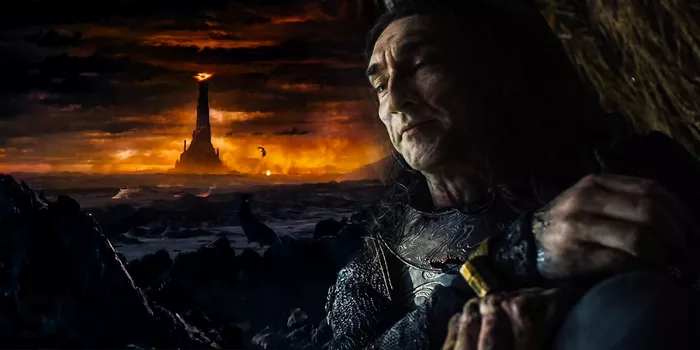Diving into the intricate web of Tolkien’s Middle-earth, Amazon’s “The Rings of Power” embarks on a journey that reshapes the origins of Mordor. A narrative tapestry that weaves seamlessly into J.R.R. Tolkien’s established “Lord of the Rings” mythos, the show delves into the Second Age, breathing life into younger versions of beloved characters such as Galadriel, Elrond, and the Moria dwarves. Against the backdrop of cataclysmic events, including the forging of the Rings of Power, the series sets the stage for the momentous events that culminate in the epic saga chronicled in “The Lord of the Rings.”
The inaugural season unraveled the intricate machinations of Sauron the Deceiver, whose guise as a deposed King of the Southlands befriended Galadriel in a cunning ploy. This enigmatic journey led both immortals into the hands of the Numenoreans, navigating a path reminiscent of Aragorn’s saga. Unbeknownst to all, the Southlands underwent usurpation by Sauron’s allies, a secret harbored beneath the surface of their alliance. Amidst the struggle against dark forces, the season climaxed with the awakening of Mordor, its dormant history stirring to life after the era of Morgoth.
The beauty of “The Rings of Power” lies in its ability to seamlessly interlace its narrative with Tolkien’s established lore. The show’s compressed timeline condenses centuries of events into a cohesive narrative, offering viewers an accessible pathway through Middle-earth’s expansive mythos. Furthermore, the series introduces subplots that harmoniously coexist within the established canon, enriching the tapestry of the fantasy realm. Amidst this narrative alchemy, pivotal moments emerge, altering the course of Middle-earth’s history.
A significant pivot in the narrative occurs in Episode 6, when a village inhabitant unwittingly activates a mysterious sword amidst a battle against Orcs in the Southland. The resultant volcanic eruption from Mount Doom reverberates across the terrain, leaving an indelible mark on the landscape. This event, while condensed for storytelling purposes, seamlessly aligns with the grandeur of Tolkien’s universe.
The origins of Mordor, though altered in presentation, remain true to the essence of Tolkien’s creation. Long before Mordor, Angband stood as a dominion where Morgoth, Sauron’s predecessor, reigned supreme. The creation of volcanic landscapes and treacherous mountains fortified the land, safeguarding Morgoth’s reign. The fall of Angband in the First Age prompted Morgoth to rebuild, birthing the concept of Mordor. With unholy power, Morgoth conjured Mount Doom, which remained dormant for years before awakening.
As “The Rings of Power” delves deeper, the intricate dynamics behind the construction of Mordor emerge. Sauron and Adar collaborate, weaving a complex tapestry that spans creating an indestructible sword serving as a key to a dam mechanism, digging trenches with a legion of minions, relying on the Elves’ selective perception of Sauron’s iconography, and orchestrating the release of flood gates leading to Mount Doom’s eruption. This rich detailing adds layers to Mordor’s narrative that did not exist in Tolkien’s original lore, creating a compelling dichotomy between adaptation and authenticity.
Within this complexity lies a recurring theme central to both Tolkien’s works and “The Rings of Power”: the concept of evil’s corruptive nature. Mordor’s genesis echoes this motif, exemplifying how malevolent forces twist and taint their surroundings. As Sauron, Adar, and their allies embark on their cataclysmic ambitions, a wave of devastation is unleashed. The shadow realm they forge reflects the potent message that evil’s capacity lies in destruction, manipulation, and the distortion of the natural world.
As the inaugural season concludes, anticipation mounts for the second installment of “The Rings of Power.” The transformation of Mordor following Mount Doom’s eruption beckons completion. Elements like the iconic gate, Barad-dur, and the deeper exploration of the driving forces behind Mordor’s creation invite further exploration. The intricate relationship between Morgoth, Sauron, and Adar fuels intrigue, while the potential unveiling of Adar’s true powers hints at a narrative of untold depth.
Mordor’s evolution remains a focal point of anticipation and fascination. The transformation of a once-lush realm into a crucible of darkness and corruption offers a poignant commentary on industrialization’s destructive forces. A dynamic parallel emerges between the fictional world and our own, underscoring themes Tolkien himself approached with gravity. As “The Rings of Power” embarks on its second season, the narrative’s resonance lies in its ability to encapsulate the destructive allure of evil.
The creation of Mordor is a triumph of adaptation and storytelling, mirroring Tolkien’s world-building prowess. As the series continues, the journey through Middle-earth’s intricacies promises a blend of innovative narrative choices and fidelity to the essence of Tolkien’s legacy. Mordor’s transformation stands as a potent reminder of the shadows that threaten to engulf even the most pristine realms—a cautionary tale that resonates across time and space.
RELEATED READING:
-
Leonardo DiCaprio Faces Loyalty Dilemma in Intense Killers of the Flower Moon Trailer
-
Joaquin Phoenix Shines in Ridley Scott’s Napoleon Trailer
-
Jon Hamm Returns to the Cubicle in Hilarious Corner Office Trailer
-
The Nun II Unleashes More Terror in Hair-Raising Trailer Starring Taissa Farmiga

